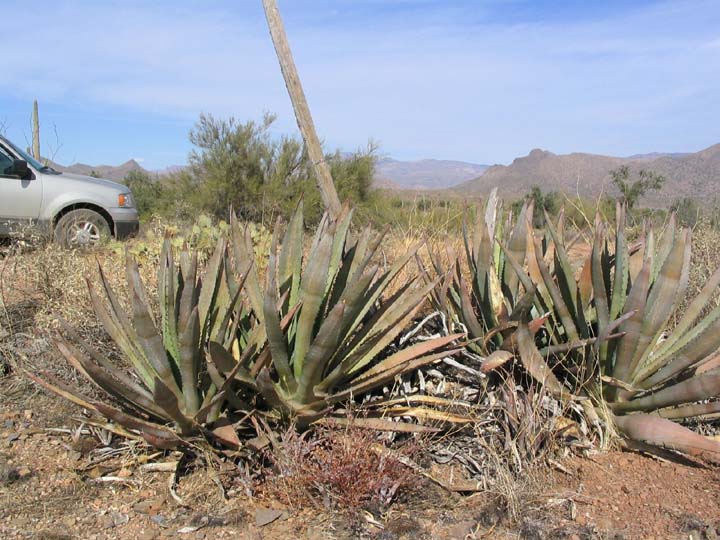
|
|
|
|
Family: Asparagaceae
Hohokam Century-Plant, more...Murphey's century plant, Hohokam agave, Murphey agave, Murphey's Striped Agave
|
Plants acaulescent, freely suckering; rosettes cespitose, 6-12 × 8-14 dm, open. Leaves ascending, 50-80 × 6-10 cm; blade light glaucous green to yellow green, frequently lightly cross-zoned, spatulate, firm, adaxially concave toward apex, abaxially convex toward base; margins undulate, armed, teeth single, well defined, mostly 3-4 mm, ca. 1-2 cm apart; apical spine dark brown to grayish, conical, 1.2-2 cm. Scape 3-4 m. Inflorescences narrowly paniculate, prolifically bulbiferous; bracts persistent, triangular, 10-15 cm; lateral branches 10-16, slightly ascending, comprising distal 1/4 of inflorescence, longer than 10 cm. Flowers 12-21 per cluster, erect, (5.1-)6-7.5 cm; perianth cream, apex purplish or brownish, tube urceolate, 14-20 × (11-)14-19 mm, limb lobes erect, unequal, (14-)15-20 mm; stamens long-exserted; filaments inserted unequally at or slightly above mid perianth tube, erect, yellow, (3.3-)4.5-5 cm; anthers yellow, (16-)22-25 mm; ovary (1.8-)2.2-4 cm, neck slightly constricted, (0.5-)4-6 mm. Capsules short-pedicellate, obovate to oblong or ovate, 5-7 cm, apex short-beaked. Seeds (7-)9-11 mm. 2n = 60. Flowering late winter--spring. Near drainage systems in desert scrub; of conservation concern; 400--1000 m; Ariz.; nw Mexico. Agave murpheyi, used by the Hohokam for food, is known only from around pre-Columbian agricultural and settlement areas. The plants (including bulbils) are easily transported and transplanted. Agave murpheyi hybridizes with A. chrysantha in Arizona.
Plant: perennial herb; Rosettes caespitose, ca. 0.6-1.2 m high, 0.8-1.4 m broad Leaves: numerous, 50-80 cm long, 6-10 cm wide, linear-spathulate, broadest just above middle, short-acuminate, ascending, firm, thin, shallowly concave towards apex, thickish and convex towards base, easily cut, light glaucous green to yellowish-green, often with light cross-zoned patterns, the margins undulate; teeth small, 3-4 mm long, mostly porrect to leaf edge to upwardly flexed, mostly 1-2 cm apart, dark brown to black or gray; interstitial teeth absent; terminal spine short, thick, 12-20 mm long, conical, dark brown to pruinose gray, decurrent 3.4-5 cm down to uppermost teeth INFLORESCENCE: with scape 3-4 m tall, narrowly paniculate, compact, of 10-16 short, ascending lateral branchlets in upper 1/4 of flowering stalk, the stalk thickish, green Flowers: in congested umbels, thick, stout, 51-75 mm long; tepals persistently erect, slightly clasping filaments, leathery, unequal, cream, the outer ones 15-19 mm long, 5-7 mm wide, with roughened, thick, brownish hooded tip, the inner ones 14-17 mm long, 4-5 mm wide; filaments (33-)45-50 mm long, inserted unequally, (6.5-)8-12 mm above base of tube, cream or pale yellow, the anthers (16-)22-26 mm long, yellow; ovary (18-)22-40 mm long, with a scarcely narrowed neck 0.5-3(-5) mm long, pale cream-green, waxy, the style 3.4-5 cm long when stigma is receptive, cream-yellow; floral tube deep, 14-20 mm long, (11-)14-19 mm broad, slightly bulging at base of tepals, pale cream-green Fruit: capsules, 5-6.9 cm long, 2-2.8 cm broad, narrowly obovate to oblong or ovate-oblong, long stipitate and beaked, bulbils always produced on pedicels; SEEDS thin, (7-)9-11 mm long, 6-7 mm broad Misc: -Usually in close proximity of major drainage systems on open hilly slopes or alluvial terraces in desert scrub with pre-Columbian agricultural and settlement features, having been cultivated by the Hohokam; 400-900 m (1350-2950 ft); Mar-Jul References: Hodgson, Wendy. 1999. Agavaceae. Ariz. - Nev. Acad. Sci. 32(1). |
|
|
|
This project was made possible in part by the Institute of Museum and Library Services [MG-70-19-0057-19].
Powered by Symbiota



